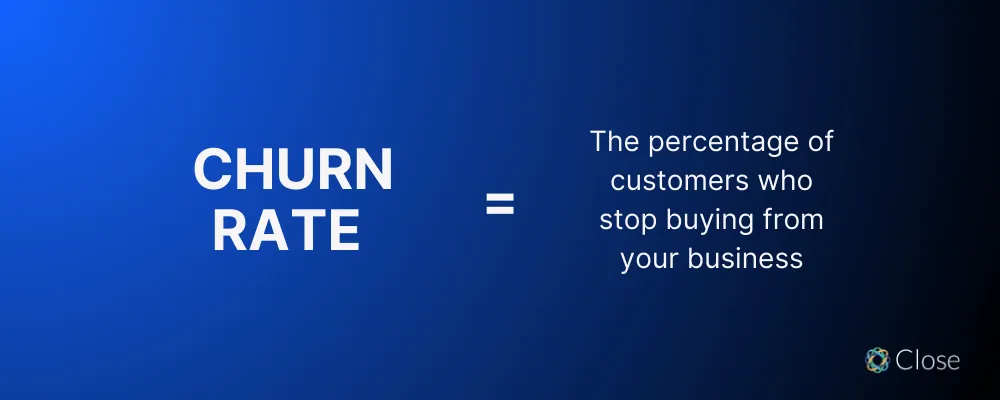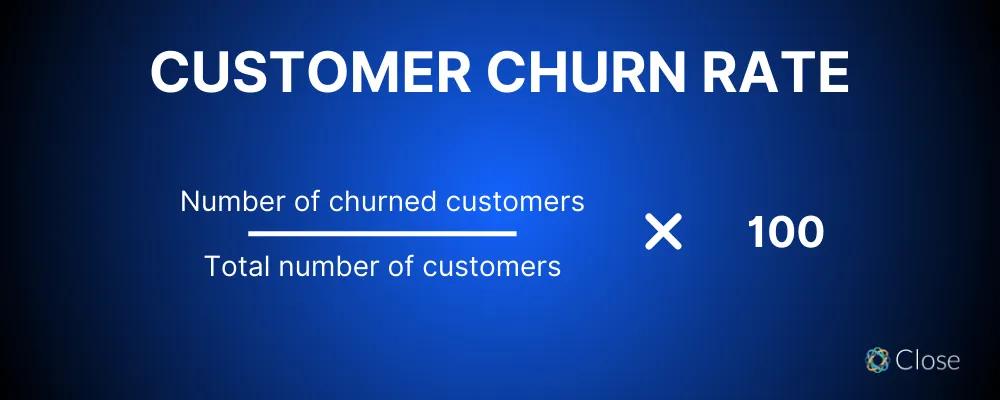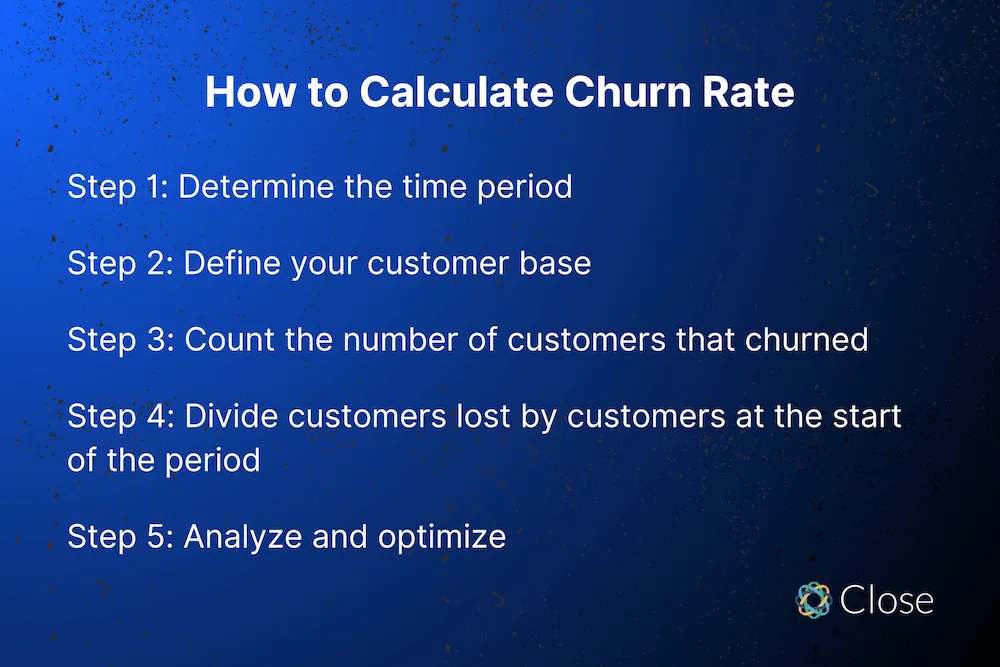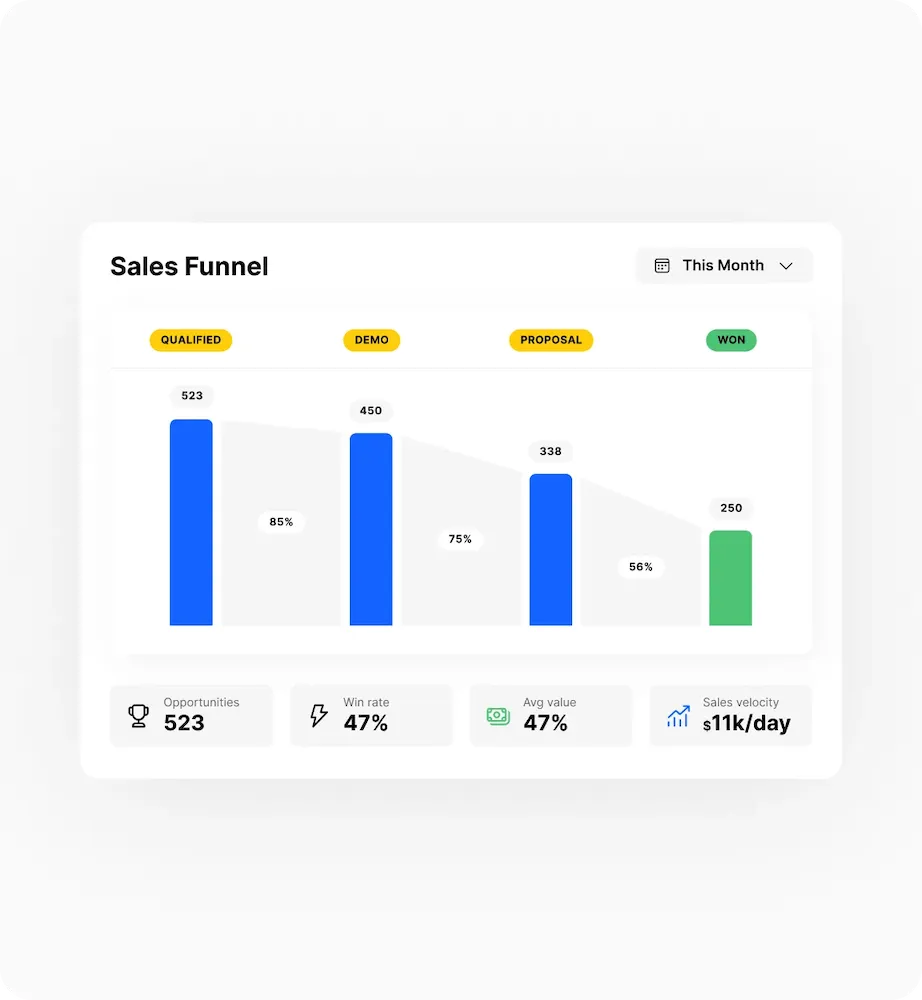
You could be welcoming a truckload of new customers in the front door; but if you’re not tracking your churn rate, you could be losing more of your existing customers out the back.
If you want to become (or remain) profitable, churn rate is one of the most important metrics you should be tracking.
Ready to see if you’re losing more customers than you’re acquiring?
Let’s see how to calculate your customer churn rate, and benchmarks for success, along with tips to reduce that churn and boost profitability.
What is Churn Rate?
 |
Churn can be calculated by the number of customers who stop purchasing, or the amount of revenue you lose when those existing customers say adios to your business.
For example, here’s a simple churn rate calculation:
Customer churn rate = (Customers lost during time period / Total number of customers at the start) * 100
 |
If you want to see this in terms of the financial impact, use this revenue churn rate formula:
Revenue churn rate = (Revenue lost during time period / Total revenue at the start) * 100
 |
On the other hand, negative churn refers to acquiring more customers than you lose. If you lose 50 customers but acquire 78 new ones over the same period, income from the new customers will replace the revenue lost through churn.
Churn rate is an especially popular SaaS metric, and subscription businesses rely on it to guide customer retention strategies. But this KPI is useful across many industries, so keep reading.
Why Churn Analysis is Essential to Tracking Business Growth
Tracking churn is key to building better customer retention. So if you’re wondering if it’s worth it, just remember: increasing customer retention rates by just 5 percent increases profits by 25 to 95 percent.
When you do regular churn analysis and track your annual churn rate, you’ll see:
- Whether you’re retaining the customers you acquire
- The level of customer satisfaction and loyalty
- If your customer acquisition costs would be better spent on helping existing customers stay on
- Whether your current growth will be sustainable in the long term
Of course, you don’t track churn in a vacuum—watch this essential sales KPI alongside others, including your revenue growth rate, customer acquisition costs (CAC), MRR and ARR, and customer lifetime value. That way, you’ll have a full picture of your sales health and customer base.
Remember: churn compounds over time. What might sound like a low percentage of cancellations can ultimately cost your business thousands of dollars each year.
Churn Rate Benchmarks: How Does Your Company Compare?
Do you have a good churn rate—one that’s on par with the competition or in your industry?
Recurly Research reports that the average churn rate in B2B is 4.91 percent. And B2C sees 6.77 percent.
About 3.9 percent of churn is voluntary—due to customer dissatisfaction. And about 1.4 percent is involuntary—due to payment issues.
According to Paddle, the average churn rate for SaaS companies falls between 2 and 8 percent of MRR. This supports Recurly’s research, which shows the average churn rate in software landing around 4.75 percent.
Consumer goods and retail sees 7.55 percent, healthcare 6.03 percent—and the list goes on.
Of course, other factors can impact the number of churned customers you see in a given period, including the age and size of the company, or the pricing structure. So, watch your industry benchmarks, but remember to use your own numbers to benchmark progress over time.
How to Calculate Churn Rate in 5 Easy(ish) Steps
We know the formula, but let’s narrow down the exact steps to calculate churn rate for your business (and monitor it over time).
 |
Step 1: Determine the Time Period
Subscription-based businesses might track their churn rate on a monthly basis (based on usage patterns or payment structures), while another B2B company may track it quarterly.
Choose a time period that fits your industry, the frequency of customer interactions, and your pricing and subscription model. That way, you can track and compare your churn rates over time, and make data-driven decisions.
Step 2: Define your Customer Base
Use your CRM or another data tool to define the number of customers you had at the beginning of your chosen time period. Exclude any new customers.
If you want to get more granular, segment your current customers by demographics, subscription details (like pricing tier), acquisition channel, or product use case. This cohort analysis can help you identify trends and prioritize the right activities.
Step 3: Count the Number of Customers that Churned
Now, it’s time to see how many customers churned. If you’re using a data-savvy CRM, like Close, you’ll be able to find this information with its built-in reporting features.
 |
Keep this information handy, so you can always make data-smart decisions. Want to see how Close can help?
Step 4: Divide Customers Lost by Customers at the Start of the Period
Time to grab your churn rate formula!
Divide the number of customers lost during the period (Step 3) by the total number of customers you had at the start of that same period (Step 2). Then, multiply the result by 100 to express the churn rate as a percentage.
Step 5: Analyze and Optimize
Yes, this is an ongoing process. (Didn’t think you’d finish that easily, did ya?)
If you want this data to be meaningful, you need to compare it to industry benchmarks and to previous periods within your own business. That way, you can identify trends, and turn that data into actions.
Here are some ways you can analyze your churn rate data:
- Look for common characteristics or behaviors with customers who churn
- Compare churn rates between different segments
- Track churn rates over time to spot patterns (such as seasonality)
Your goal here: understand why customers churn, and what you can do to stop it. Use the data you’ve collected to inform your decisions, and you’ll have a better shot at improving customer retention (and ultimately growing your business).
Strategies to Fix a High Customer Churn Rate
Customers churn for different reasons, including:
- Product or service quality
- Price sensitivity
- No product/market fit
- Bad user or customer experience
So, what actions can you take to reduce that churn rate?
Even the smallest decrease in churn can have a big impact on your bottom line. So, let’s take a look at actionable ways to prevent churn before it happens:
- Refine your ICPs and buyer personas: Selling to bad-fit customers is a huge reason for churn. Instead, spend time getting a crystal-clear picture of the customers who get the most value from your solution. Then, tailor your messaging, in-app experience, and sales pitches around them. Better-fit customers are less likely to churn.
- Offer superior customer support: Take a proactive approach to support—don’t just reach out when there are issues. Analyze customer behavior to identify potential churn, and help resolve issues before they escalate. Over 60 percent of SaaS business customers churn because of a bad customer success experience, so be open to feedback and quick to improve.
- Contact customers with soon-to-expire payment methods: Passive churn happens when you try to draw the next payment, and the customer’s credit card is expired. Use dunning software like Paddle to remind customers when their card is expiring and make sure happy customers don’t churn by accident.
- Push annual subscriptions over monthly billing: Paddle research shows that churn rates are lower at companies that have a higher percentage of annual contracts. Nudge new customers toward annual plans with discounted prices (such as one month free). This is an a-okay and super-normal way to implement discounts.
- Match onboarding preferences to pain points: Out-of-touch onboarding sucks. So, learn about what matters to your customers and personalize their onboarding process to match their pain points.
These strategies can help you preempt churn—but what if a customer is already at the point where they’re ready to cancel? Here are two things you should do that can help reduce churn:
- Offer downgrades (and discounted upgrades) during the cancelation process: Churning customers are often looking for a better deal—somewhere else. Instead, bring it to them by offering to downgrade to a less expensive plan, or upgrade to add extra features at teh same (or discounted) price. Just be careful—discounts can be a slippery slope.
- Ask customers why they’re canceling: If nothing else, a churning customer can help you get insights into why churn happens. Use customer surveys, or even call them up! If they hesitate to leave feedback, offer an incentive. After all, if churn is draining your profits, that $10 Starbucks gift card will be worth the insights you get.
Don’t Allow a High Churn Rate to Sabotage Profits
Customer churn is a compounding issue that needs to be solved ASAP. Neglect it, and you’ll watch revenue dwindle, growth rates suffer, and the longevity of your company slowly slip away.
There is a clear financial incentive for reducing churn. It also leads to more accurate sales forecasting and better customer satisfaction. And even if it hits the benchmark, remember: the lower your churn rate, the better.
So, in the pursuit of that low churn rate, study yours: calculate it (via cohort analysis if necessary) and implement strategies to improve it.
It might seem like a hopeless, time-consuming task at times, but stick with it. It pays dividends (literally).
Need help managing your sales process and tracking your churn rate? Close provides built-in, user-friendly features like reporting and automated outreach to boost your growth—sustainably.










